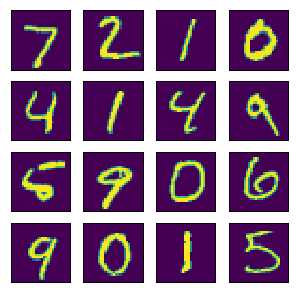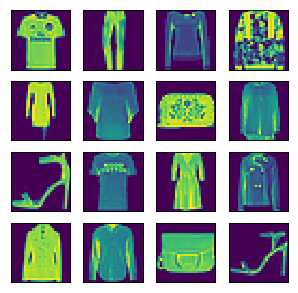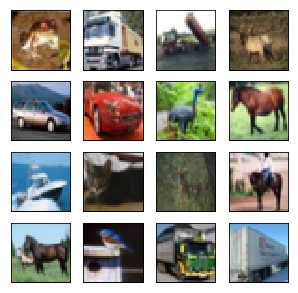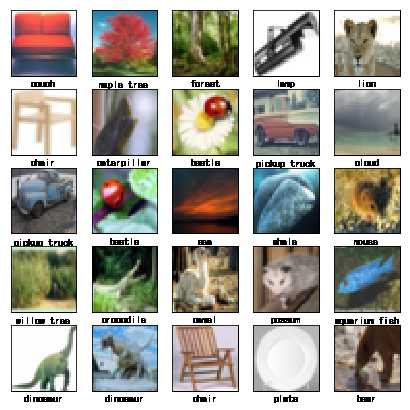深度学习常用数据集 API
2021-07-01 13:07
标签:encode for with open 字体 年龄 代码 测试 还需 .data 深度学习中经常会使用一些基准数据集进行一些测试。其中 MNIST, Cifar 10, cifar100, Fashion-MNIST 数据集常常被人们拿来当作练手的数据集。为了方便,诸如 我使用了 我是在 Jupyter Notebook 交互环境中运行代码的。 为了更好的使用该 API, 我利用了 Bunch 结构。在 Python 中,我们可以定义 Bunch Pattern, 字面意思大概是指链式的束式结构。主要用于存储松散的数据结构。 它能让我们以命令行参数的形式创建相关对象,并设置任何属性。下面我们来看看 Bunch 的魅力!Bunch 的定义利用了 下面我们构建一个 Bunch 的实例 我们可以查看 Tom 的一些信息: 我们还可以直接对 Tom 增加属性,比如: 你也许会奇怪,Bunch 结构与 从上面的输出我们可以看出, 链接: 我们将上述数据集均下载到同一个目录下,比如: MNIST 数据集可以说是深度学习中的 MNIST 数据集来自美国国家标准与技术研究所(National Institute of Standards and Technology, NIST). 训练集 (training set) 由来自 250 个不同人手写的数字构成, 其中 \(50\%\) 是高中学生, \(50\%\) 来自人口普查局 (the Census Bureau) 的工作人员. 测试集(test set) 也是同样比例的手写数字数据. MNIST 有一组 \(60\, 000\) 个样本的训练集和一组 \(10\, 000\) 个样本的测试集。它是 NIST 的子集。数字图像已被大小规范化, 并以固定大小的图像居中。 MNIST 数据集可在 http://yann.lecun.com/exdb/mnist/ 获取, 它包含了四个部分: 图像分类数据集中最常用的是手写数字识别数据集 MNIST1。但大部分模型在 MNIST 上的分类精度都超过了 \(95\%\)。为了更直观地观察算法之间的差异,我们可以使用一个图像内容更加复杂的数据集 Fashion-MNIST2。Fashion-MNIST 和 MNIST 一样,也包括了 \(10\) 个类别,分别为:t-shirt(T 恤)、trouser(裤子)、pullover(套衫)、dress(连衣裙)、coat(外套)、sandal(凉鞋)、shirt(衬衫)、sneaker(运动鞋)、bag(包)和 ankle boot(短靴)。 Fashion-MNIST 的存储方式和 MNIST 是一样的,故而,我们可以使用相同的方式对其进行处理。 下面我以 下面,我们来看看如何载入这两个数据集? 考虑到代码的可复用性,我将上述代码封装在我的 GitHub3 首先,需要找到你下载的 API 目录,比如: 下面你便可以自如的调用 MNIST 类了。 下面我们以 MNIST 的测试集为例,来看看 MNIST 具体长什么样吧! 再看看 Fashion MNIST 具体长什么样吧! MNIST 和 Fashion MNIST 数据集还是太简单了,为了满足更多的需求,下面我们将进入 Cifar 数据集的 API 开发和使用环节。 为了方便管理和调用数据集,我定义了一个 同样将上述代码放入 下面我们便可以直接利用 我们可以查看,我们封装的数据集: 由于前面已经展示过 ‘mnist‘, ‘fashion_mnist‘,下面我们将展示 Cifar API 的使用。更多详细内容参考我的博文 关于 『AI 专属数据库的定制』的改进4。 cifar-10 和 CIFAR-10 标记为 \(8000\) 万个 微小图像数据集5的子集。它们是由 Alex Krizhevsky, Vinod Nair, 和 Geoffrey Hinton 收集的。 cifar-10 数据集由 \(10\) 类 \(32\times 32\) 彩色图像组成, 每类有 \(6\,000\) 张图像。被划分为 \(50\,000\) 张训练图像和 \(10\,000\) 张测试图像。 为了方便数据的使用,我们可以将 这样以后我们就可以直接复制 考虑到 JSON 对于其他编程语言的不友好,下面我们将介绍如何将 Bunch 数据集存储为 HDF5 格式的数据。 下面的代码均是在 Jupyter NoteBook 下完成的: 从上面的结构可看出我将 下面我们以 可以使用 例如,我们可以看看训练集的数据和标签: 当然,我们也可以直接使用 更甚者,我们可以直接定义迭代器来获取数据: 更多使用详情见:使用 迭代器 获取 Cifar 等常用数据集8 为了更加形象的说明该数据集,我们将其可视化: 为了高效使用数据集 上面的大部分代码被我放在了 Github:https://github.com/DataLoaderX/basedataset/tree/master/loader。 上面的 API 设计过程中,我发现到了许多自身的不足,不断改进 API 的过程中,我获得了学习和创造的喜悦。上面所介绍的 LeCun, Y., Cortes, C., & Burges, C. http://yann.lecun.com/exdb/mnist/? Xiao, H., Rasul, K., & Vollgraf, R. (2017). Fashion-mnist: a novel image dataset for benchmarking machine learning algorithms. arXiv preprint arXiv:1708.07747.? https://github.com/DataLoaderX/basedataset/tree/master/loader? https://www.jianshu.com/p/29066e70ea5e? http://people.csail.mit.edu/torralba/tinyimages/? http://www.pytables.org/? http://www.hdfgroup.org? https://yq.aliyun.com/articles/614332?spm=a2c4e.11155435.0.0.30543312vFsboY? 深度学习常用数据集 API 标签:encode for with open 字体 年龄 代码 测试 还需 .data 原文地址:https://www.cnblogs.com/q735613050/p/9951678.html基准数据集
Keras、MXNet、Tensorflow 都封装了自己的基础数据集,如 MNIST、cifar 等。如果我们要在不同平台使用这些数据集,还需要了解那些框架是如何组织这些数据集的,需要花费一些不必要的时间学习它们的 API。为此,我们为何不创建属于自己的数据集呢?下面我仅仅使用了 Numpy 来实现数据集 MNIST、Fashion MNIST、Cifa 10、Cifar 100 的操作,并封装为 HDF5,这样该数据集的可扩展性就会大大的增强,并且还可以被其他的编程语言 (如 Matlab) 来获取和使用。下面主要介绍如何通过创建的 API 来实现数据集的封装。环境搭建
Anaconda3 这个十分好用的包管理工具, 来减少管理和安装一些必须的包。下面我们载入该 API 必备的包:import struct # 处理二进制文件
import numpy as np # 对矩阵运算很友好
import gzip, tarfile # 对压缩文件进行处理
import os # 管理本地文件
import pickle # 序列化和反序列化
import time # 记时Bunch 结构
dict 的特性。class Bunch(dict):
def __init__(self, *args, **kwds):
super().__init__(*args, **kwds)
self.__dict__ = selfTom, 它代表一个住在北京的 54 岁的人。Tom = Bunch(age="54", address="Beijing")print(‘Tom 的年龄是 {},他住在 {}.‘.format(Tom.age, Tom.address))Tom 的年龄是 54,他住在 Beijing.Tom.sex = ‘male‘
print(Tom){‘age‘: ‘54‘, ‘address‘: ‘Beijing‘, ‘sex‘: ‘male‘}dict 结构好像没有太大的的区别,只不过是多了一个点号运算,那么,Bunch 到底有什么神奇之处呢?我们先看一个例子:T = Bunch
t = T(left=T(left=‘a‘,right=‘b‘), right=T(left=‘c‘))
for first in t:
print(‘第一层的节点:‘, first)
for second in t[first]:
print(‘\t第二层的节点:‘, second)
for node in t[first][second]:
print(‘\t\t第三层的节点:‘, node)第一层的节点: left
第二层的节点: left
第三层的节点: a
第二层的节点: right
第三层的节点: b
第一层的节点: right
第二层的节点: left
第三层的节点: ct 便是一个简单的二叉树结构。这样,我们便可使用 Bunch 构建许多具有分层结构的数据类型。下载数据集
‘E:/Data/Zip/‘,下面我们将逐一介绍上述数据集。MNIST & Fashion MNIST
hello world 级别的数据集,很多教程都是把它作为入门级的数据集。不过有些人可能对它还不是很了解, 下面我们简单的了解一下!
MNIST 的使用
MNIST 类来处理 MNIST 和 Fashion MNIST:class MNIST:
def __init__(self, root, namespace, train=True, transform=None):
"""
(MNIST handwritten digits dataset from http://yann.lecun.com/exdb/mnist)
(A dataset of Zalando‘s article images consisting of fashion products,
a drop-in replacement of the original MNIST dataset
from https://github.com/zalandoresearch/fashion-mnist)
Each sample is an image (in 3D NDArray) with shape (28, 28, 1).
Parameters
----------
root : 数据根目录,如 ‘E:/Data/Zip/‘
namespace : ‘mnist‘ or ‘fashion_mnist‘
train : bool, default True
Whether to load the training or testing set.
transform : function, default None
A user defined callback that transforms each sample. For example:
::
transform=lambda data, label: (data.astype(np.float32)/255, label)
"""
self._train = train
self.namespace = namespace
root = root + namespace
self._train_data = f‘{root}/train-images-idx3-ubyte.gz‘
self._train_label = f‘{root}/train-labels-idx1-ubyte.gz‘
self._test_data = f‘{root}/t10k-images-idx3-ubyte.gz‘
self._test_label = f‘{root}/t10k-labels-idx1-ubyte.gz‘
self._get_data()
def _get_data(self):
‘‘‘
官方网站的数据是以 `[offset][type][value][description]` 的格式封装的,
因而 `struct.unpack` 时需要注意
‘‘‘
if self._train:
data, label = self._train_data, self._train_label
else:
data, label = self._test_data, self._test_label
with gzip.open(label, ‘rb‘) as fin:
struct.unpack(">II", fin.read(8))
self.label = np.frombuffer(fin.read(), dtype=np.uint8)
with gzip.open(data, ‘rb‘) as fin:
Y = struct.unpack(">IIII", fin.read(16))
data = np.frombuffer(fin.read(), dtype=np.uint8)
self.data = data.reshape(Y[1:])MNIST
。将其下载到本地,你便可以直接使用。下面我将展示如何使用该 API。D:\GitHub\basedataset\loader,然后载入到你当前的 Python 环境变量中。import sys
sys.path.append(‘D:/GitHub/basedataset/loader/‘)
from zdata import MNISTroot = ‘E:/Data/Zip/‘
namespace = ‘mnist‘
train_mnist = MNIST(root, namespace, train=True, transform=None) # 获取训练集
test_mnist = MNIST(root, namespace, train=False, transform=None) # 获取测试集
print(‘MNIST 的训练集规模:{}‘.format((train_mnist.data.shape)))
print(‘MNIST 的测试集规模:{}‘.format((test_mnist.data.shape)))MNIST 的训练集规模:(60000, 28, 28)
MNIST 的测试集规模:(10000, 28, 28)from matplotlib import pyplot as plt
def show_imgs(imgs):
‘‘‘
展示 多张图片
‘‘‘
n = imgs.shape[0]
h, w = 4, int(n / 4)
_, figs = plt.subplots(h, w, figsize=(5, 5))
K = np.arange(n).reshape((h, w))
for i in range(h):
for j in range(w):
img = imgs[K[i, j]]
figs[i][j].imshow(img)
figs[i][j].axes.get_xaxis().set_visible(False)
figs[i][j].axes.get_yaxis().set_visible(False)
plt.show()imgs = test_mnist.data[:16]
show_imgs(imgs)
Fashion MNIST
namespace = ‘fashion_mnist‘
train_mnist_f = MNIST(root, namespace, train=True, transform=None)
test_mnist_f = MNIST(root, namespace, train=False, transform=None)
print(‘Fashion MNIST 的训练集规模:{}‘.format((train_mnist_f.data.shape)))
print(‘Fashion MNIST 的测试集规模:{}‘.format((test_mnist_f.data.shape)))Fashion MNIST 的训练集规模:(60000, 28, 28)
Fashion MNIST 的测试集规模:(10000, 28, 28)imgs_f = test_mnist_f.data[:16]
show_imgs(imgs_f)
Cifar API
class Bunch(dict):
def __init__(self, *args, **kwds):
super().__init__(*args, **kwds)
self.__dict__ = self
class Cifar(Bunch):
def __init__(self, root, namespace, transform=None, *args, **kwds):
"""CIFAR image classification dataset
from https://www.cs.toronto.edu/~kriz/cifar.html
Each sample is an image (in 3D NDArray) with shape (32, 32, 3).
Parameters
----------
meta : 保存了类别信息
root : str, 数据根目录
namespace : ‘cifar-10‘ 或 ‘cifar-100‘
transform : function, default None
A user defined callback that transforms each sample. For example:
::
transform=lambda data, label: (data.astype(np.float32)/255, label)
"""
super().__init__(*args, **kwds)
self.url = ‘https://www.cs.toronto.edu/~kriz/cifar.html‘
self.namespace = namespace
self._extract(root)
self._read_batch()
def _extract(self, root):
tar_name = f‘{root}{self.namespace}-python.tar.gz‘
names = extractall(tar_name, root)
# print(‘载入数据的字典信息:‘)
#start = time.time()
for name in names:
path = f‘{root}{name}‘
if os.path.isfile(path):
if not (path.endswith(‘.html‘) or path.endswith(‘.txt~‘)):
k = name.split(‘/‘)[-1]
if path.endswith(‘meta‘):
with open(path, ‘rb‘) as fp:
self[‘meta‘] = pickle.load(fp)
else:
with open(path, ‘rb‘) as fp:
self[k] = pickle.load(fp, encoding=‘bytes‘)
# #time.sleep(0.2)
# t = int(time.time() - start) * ‘-‘
# print(t, end=‘‘)
# print(‘\n载入数据的字典信息完毕!‘)
def _read_batch(self):
if self.namespace == ‘cifar-10‘:
self.trainX = np.concatenate([
self[f‘data_batch_{str(i)}‘][b‘data‘] for i in range(1, 6)
]).reshape(-1, 3, 32, 32).transpose((0, 2, 3, 1))
self.trainY = np.concatenate([
np.asanyarray(self[f‘data_batch_{str(i)}‘][b‘labels‘])
for i in range(1, 6)
])
self.testX = self.test_batch[b‘data‘].reshape(
-1, 3, 32, 32).transpose((0, 2, 3, 1))
self.testY = np.asanyarray(self.test_batch[b‘labels‘])
elif self.namespace == ‘cifar-100‘:
self.trainX = self.train[b‘data‘].reshape(-1, 3, 32, 32)
self.train_fine_labels = np.asanyarray(
self.train[b‘fine_labels‘]) # 子类标签
self.train_coarse_labels = np.asanyarray(
self.train[b‘coarse_labels‘]) # 超类标签
self.testX = self.test[b‘data‘].reshape(-1, 3, 32, 32)
self.test_fine_labels = np.asanyarray(
self.test[b‘fine_labels‘]) # 子类标签
self.test_coarse_labels = np.asanyarray(
self.test[b‘coarse_labels‘]) # 超类标签DataBunch 类:class DataBunch(Bunch):
‘‘‘
将数据集转换为 Bunch
‘‘‘
def __init__(self, root, *args, **kwds):
super().__init__(*args, **kwds)
B = Bunch
self.mnist = B(MNIST(root, ‘mnist‘))
self.fashion_mnist = B(MNIST(root, ‘fashion_mnist‘))
self.cifar10 = B(Cifar(root, ‘cifar-10‘))
self.cifar100 = B(Cifar(root, ‘cifar-100‘))zdata 模块中。Cifar 10 数据集
DataBunch 类来调用上述介绍的数据集:import sys
sys.path.append(‘D:/GitHub/basedataset/loader/‘)
from zdata import DataBunch, show_imgsroot = ‘E:/Data/Zip/‘
db = DataBunch(root)db.keys()dict_keys([‘mnist‘, ‘fashion_mnist‘, ‘cifar10‘, ‘cifar100‘])cifar10 = db.cifar10
imgs = cifar10.trainX[:16]
show_imgs(imgs)
db 写入到本地磁盘:序列化
import pickle
def write_bunch(path):
‘‘‘
path:: 写入数据集的文件路径
‘‘‘
with open(path, ‘wb‘) as fp:
pickle.dump(db, fp)root = ‘E:/Data/Zip/‘
path = f‘{root}X.json‘ # 写入数据集的文件路径
write_bunch(path)f‘{root}X.dat 或 f‘{root}X.json‘ 到你可以放置的任何地方,然后你就可以通过 load 函数来调用 MNIST、Fashion MNIST、Cifa 10、Cifar 100 这些数据集。即:反序列化
def read_bunch(path):
with open(path, ‘rb‘) as fp:
bunch = pickle.load(fp) # 即为上面的 DataBunch 的实例
return bunchdb = read_bunch(path) # path 即你的数据集所在的路径Bunch 转换为 HDF5 文件:高效存储 Cifar 等数据集
PyTables6 是 Python 与 HDF5 数据库/文件标准的结合7。它专门为优化 I/O 操作的性能、最大限度地利用可用硬件而设计,并且它还支持压缩功能。import tables as tb
import numpy as np
def bunch2hdf5(root):
‘‘‘
这里我仅仅封装了 Cifar10、Cifar100、MNIST、Fashion MNIST 数据集,
使用者还可以自己追加数据集。
‘‘‘
db = DataBunch(root)
filters = tb.Filters(complevel=7, shuffle=False)
# 这里我采用了压缩表,因而保存为 `.h5c` 但也可以保存为 `.h5`
with tb.open_file(f‘{root}X.h5c‘, ‘w‘, filters=filters, title=‘Xinet\‘s dataset‘) as h5:
for name in db.keys():
h5.create_group(‘/‘, name, title=f‘{db[name].url}‘)
if name != ‘cifar100‘:
h5.create_array(h5.root[name], ‘trainX‘, db[name].trainX, title=‘训练数据‘)
h5.create_array(h5.root[name], ‘trainY‘, db[name].trainY, title=‘训练标签‘)
h5.create_array(h5.root[name], ‘testX‘, db[name].testX, title=‘测试数据‘)
h5.create_array(h5.root[name], ‘testY‘, db[name].testY, title=‘测试标签‘)
else:
h5.create_array(h5.root[name], ‘trainX‘, db[name].trainX, title=‘训练数据‘)
h5.create_array(h5.root[name], ‘testX‘, db[name].testX, title=‘测试数据‘)
h5.create_array(h5.root[name], ‘train_coarse_labels‘, db[name].train_coarse_labels, title=‘超类训练标签‘)
h5.create_array(h5.root[name], ‘test_coarse_labels‘, db[name].test_coarse_labels, title=‘超类测试标签‘)
h5.create_array(h5.root[name], ‘train_fine_labels‘, db[name].train_fine_labels, title=‘子类训练标签‘)
h5.create_array(h5.root[name], ‘test_fine_labels‘, db[name].test_fine_labels, title=‘子类测试标签‘)
for k in [‘cifar10‘, ‘cifar100‘]:
for name in db[k].meta.keys():
name = name.decode()
if name.endswith(‘names‘):
label_names = np.asanyarray([label_name.decode() for label_name in db[k].meta[name.encode()]])
h5.create_array(h5.root[k], name, label_names, title=‘标签名称‘)完成
Bunch到 HDF5 的转换root = ‘E:/Data/Zip/‘
bunch2hdf5(root)h5c = tb.open_file(‘E:/Data/Zip/X.h5c‘)
h5cFile(filename=E:/Data/Zip/X.h5c, title="Xinet‘s dataset", mode=‘r‘, root_uep=‘/‘, filters=Filters(complevel=7, complib=‘zlib‘, shuffle=False, bitshuffle=False, fletcher32=False, least_significant_digit=None))
/ (RootGroup) "Xinet‘s dataset"
/cifar10 (Group) ‘https://www.cs.toronto.edu/~kriz/cifar.html‘
/cifar10/label_names (Array(10,)) ‘标签名称‘
atom := StringAtom(itemsize=10, shape=(), dflt=b‘‘)
maindim := 0
flavor := ‘numpy‘
byteorder := ‘irrelevant‘
chunkshape := None
/cifar10/testX (Array(10000, 32, 32, 3)) ‘测试数据‘
atom := UInt8Atom(shape=(), dflt=0)
maindim := 0
flavor := ‘numpy‘
byteorder := ‘irrelevant‘
chunkshape := None
/cifar10/testY (Array(10000,)) ‘测试标签‘
atom := Int32Atom(shape=(), dflt=0)
maindim := 0
flavor := ‘numpy‘
byteorder := ‘little‘
chunkshape := None
/cifar10/trainX (Array(50000, 32, 32, 3)) ‘训练数据‘
atom := UInt8Atom(shape=(), dflt=0)
maindim := 0
flavor := ‘numpy‘
byteorder := ‘irrelevant‘
chunkshape := None
/cifar10/trainY (Array(50000,)) ‘训练标签‘
atom := Int32Atom(shape=(), dflt=0)
maindim := 0
flavor := ‘numpy‘
byteorder := ‘little‘
chunkshape := None
/cifar100 (Group) ‘https://www.cs.toronto.edu/~kriz/cifar.html‘
/cifar100/coarse_label_names (Array(20,)) ‘标签名称‘
atom := StringAtom(itemsize=30, shape=(), dflt=b‘‘)
maindim := 0
flavor := ‘numpy‘
byteorder := ‘irrelevant‘
chunkshape := None
/cifar100/fine_label_names (Array(100,)) ‘标签名称‘
atom := StringAtom(itemsize=13, shape=(), dflt=b‘‘)
maindim := 0
flavor := ‘numpy‘
byteorder := ‘irrelevant‘
chunkshape := None
/cifar100/testX (Array(10000, 32, 32, 3)) ‘测试数据‘
atom := UInt8Atom(shape=(), dflt=0)
maindim := 0
flavor := ‘numpy‘
byteorder := ‘irrelevant‘
chunkshape := None
/cifar100/test_coarse_labels (Array(10000,)) ‘超类测试标签‘
atom := Int32Atom(shape=(), dflt=0)
maindim := 0
flavor := ‘numpy‘
byteorder := ‘little‘
chunkshape := None
/cifar100/test_fine_labels (Array(10000,)) ‘子类测试标签‘
atom := Int32Atom(shape=(), dflt=0)
maindim := 0
flavor := ‘numpy‘
byteorder := ‘little‘
chunkshape := None
/cifar100/trainX (Array(50000, 32, 32, 3)) ‘训练数据‘
atom := UInt8Atom(shape=(), dflt=0)
maindim := 0
flavor := ‘numpy‘
byteorder := ‘irrelevant‘
chunkshape := None
/cifar100/train_coarse_labels (Array(50000,)) ‘超类训练标签‘
atom := Int32Atom(shape=(), dflt=0)
maindim := 0
flavor := ‘numpy‘
byteorder := ‘little‘
chunkshape := None
/cifar100/train_fine_labels (Array(50000,)) ‘子类训练标签‘
atom := Int32Atom(shape=(), dflt=0)
maindim := 0
flavor := ‘numpy‘
byteorder := ‘little‘
chunkshape := None
/fashion_mnist (Group) ‘https://github.com/zalandoresearch/fashion-mnist‘
/fashion_mnist/testX (Array(10000, 28, 28, 1)) ‘测试数据‘
atom := UInt8Atom(shape=(), dflt=0)
maindim := 0
flavor := ‘numpy‘
byteorder := ‘irrelevant‘
chunkshape := None
/fashion_mnist/testY (Array(10000,)) ‘测试标签‘
atom := Int32Atom(shape=(), dflt=0)
maindim := 0
flavor := ‘numpy‘
byteorder := ‘little‘
chunkshape := None
/fashion_mnist/trainX (Array(60000, 28, 28, 1)) ‘训练数据‘
atom := UInt8Atom(shape=(), dflt=0)
maindim := 0
flavor := ‘numpy‘
byteorder := ‘irrelevant‘
chunkshape := None
/fashion_mnist/trainY (Array(60000,)) ‘训练标签‘
atom := Int32Atom(shape=(), dflt=0)
maindim := 0
flavor := ‘numpy‘
byteorder := ‘little‘
chunkshape := None
/mnist (Group) ‘http://yann.lecun.com/exdb/mnist‘
/mnist/testX (Array(10000, 28, 28, 1)) ‘测试数据‘
atom := UInt8Atom(shape=(), dflt=0)
maindim := 0
flavor := ‘numpy‘
byteorder := ‘irrelevant‘
chunkshape := None
/mnist/testY (Array(10000,)) ‘测试标签‘
atom := Int32Atom(shape=(), dflt=0)
maindim := 0
flavor := ‘numpy‘
byteorder := ‘little‘
chunkshape := None
/mnist/trainX (Array(60000, 28, 28, 1)) ‘训练数据‘
atom := UInt8Atom(shape=(), dflt=0)
maindim := 0
flavor := ‘numpy‘
byteorder := ‘irrelevant‘
chunkshape := None
/mnist/trainY (Array(60000,)) ‘训练标签‘
atom := Int32Atom(shape=(), dflt=0)
maindim := 0
flavor := ‘numpy‘
byteorder := ‘little‘
chunkshape := NoneCifar10、Cifar100、MNIST、Fashion MNIST 进行了封装,并且还附带了它们各种的数据集信息。比如标签名,数字特征(以数组的形式进行封装)等。%%time
arr = h5c.root.cifar100.trainX.read() # 读取数据十分快速Wall time: 125 msarr.shape(50000, 32, 32, 3)h5c.root/ (RootGroup) "Xinet‘s dataset"
children := [‘cifar10‘ (Group), ‘cifar100‘ (Group), ‘fashion_mnist‘ (Group), ‘mnist‘ (Group)]
X.h5c 使用说明Cifar100 为例来展示我们自创的数据集 X.h5c(我将其上传到了百度云盘「链接:https://pan.baidu.com/s/1hsbMhv3MDlOES3UDDmOQiw 密码:qlb7」可以下载直接使用;亦可你自己生成,不过我推荐自己生成,可以对数据集加深理解)cifar100 = h5c.root.cifar100
cifar100/cifar100 (Group) ‘https://www.cs.toronto.edu/~kriz/cifar.html‘
children := [‘coarse_label_names‘ (Array), ‘fine_label_names‘ (Array), ‘testX‘ (Array), ‘test_coarse_labels‘ (Array), ‘test_fine_labels‘ (Array), ‘trainX‘ (Array), ‘train_coarse_labels‘ (Array), ‘train_fine_labels‘ (Array)]‘coarse_label_names‘ 指的是粗粒度或超类标签名,‘fine_label_names‘ 则是细粒度标签名。read() 方法直接获取信息,也可以使用索引的方式获取。coarse_label_names = cifar100.coarse_label_names[:]
# 或者
coarse_label_names = cifar100.coarse_label_names.read()
coarse_label_names.astype(‘str‘)array([‘aquatic_mammals‘, ‘fish‘, ‘flowers‘, ‘food_containers‘,
‘fruit_and_vegetables‘, ‘household_electrical_devices‘,
‘household_furniture‘, ‘insects‘, ‘large_carnivores‘,
‘large_man-made_outdoor_things‘, ‘large_natural_outdoor_scenes‘,
‘large_omnivores_and_herbivores‘, ‘medium_mammals‘,
‘non-insect_invertebrates‘, ‘people‘, ‘reptiles‘, ‘small_mammals‘,
‘trees‘, ‘vehicles_1‘, ‘vehicles_2‘], dtype=‘fine_label_names = cifar100.fine_label_names[:].astype(‘str‘)
fine_label_namesarray([‘apple‘, ‘aquarium_fish‘, ‘baby‘, ‘bear‘, ‘beaver‘, ‘bed‘, ‘bee‘,
‘beetle‘, ‘bicycle‘, ‘bottle‘, ‘bowl‘, ‘boy‘, ‘bridge‘, ‘bus‘,
‘butterfly‘, ‘camel‘, ‘can‘, ‘castle‘, ‘caterpillar‘, ‘cattle‘,
‘chair‘, ‘chimpanzee‘, ‘clock‘, ‘cloud‘, ‘cockroach‘, ‘couch‘,
‘crab‘, ‘crocodile‘, ‘cup‘, ‘dinosaur‘, ‘dolphin‘, ‘elephant‘,
‘flatfish‘, ‘forest‘, ‘fox‘, ‘girl‘, ‘hamster‘, ‘house‘,
‘kangaroo‘, ‘keyboard‘, ‘lamp‘, ‘lawn_mower‘, ‘leopard‘, ‘lion‘,
‘lizard‘, ‘lobster‘, ‘man‘, ‘maple_tree‘, ‘motorcycle‘, ‘mountain‘,
‘mouse‘, ‘mushroom‘, ‘oak_tree‘, ‘orange‘, ‘orchid‘, ‘otter‘,
‘palm_tree‘, ‘pear‘, ‘pickup_truck‘, ‘pine_tree‘, ‘plain‘, ‘plate‘,
‘poppy‘, ‘porcupine‘, ‘possum‘, ‘rabbit‘, ‘raccoon‘, ‘ray‘, ‘road‘,
‘rocket‘, ‘rose‘, ‘sea‘, ‘seal‘, ‘shark‘, ‘shrew‘, ‘skunk‘,
‘skyscraper‘, ‘snail‘, ‘snake‘, ‘spider‘, ‘squirrel‘, ‘streetcar‘,
‘sunflower‘, ‘sweet_pepper‘, ‘table‘, ‘tank‘, ‘telephone‘,
‘television‘, ‘tiger‘, ‘tractor‘, ‘train‘, ‘trout‘, ‘tulip‘,
‘turtle‘, ‘wardrobe‘, ‘whale‘, ‘willow_tree‘, ‘wolf‘, ‘woman‘,
‘worm‘], dtype=‘‘testX‘ 与 ‘trainX‘ 分别代表数据的测试数据和训练数据,而其他的节点所代表的含义也是类似的。trainX = cifar100.trainX
train_coarse_labels = cifar100.train_coarse_labelsarray([11, 15, 4, ..., 8, 7, 1])shape 为 (50000, 32, 32, 3),数据的获取,我们一样可以采用索引的形式或者使用 read():train_data = trainX[:]
print(train_data[0].shape)
print(train_data.dtype)(32, 32, 3)
uint8trainX 做运算。for x in cifar100.trainX:
y = x * 2
break
print(y.shape)(32, 32, 3)h5c.get_node(h5c.root.cifar100, ‘trainX‘)/cifar100/trainX (Array(50000, 32, 32, 3)) ‘训练数据‘
atom := UInt8Atom(shape=(), dflt=0)
maindim := 0
flavor := ‘numpy‘
byteorder := ‘irrelevant‘
chunkshape := NonetrainX = cifar100.trainX
train_coarse_labels = cifar100.train_coarse_labelsdef data_iter(X, Y, batch_size):
n = X.nrows
idx = np.arange(n)
if X.name.startswith(‘train‘):
np.random.shuffle(idx)
for i in range(0, n ,batch_size):
k = idx[i: min(n, i + batch_size)].tolist()
yield np.take(X, k, 0), np.take(Y, k, 0)for x, y in data_iter(trainX, train_coarse_labels, 8):
print(x.shape, y)
break(8, 32, 32, 3) [ 7 7 0 15 4 8 8 3]from pylab import plt, mpl
mpl.rcParams[‘font.sans-serif‘] = [‘SimHei‘] # 指定默认字体
mpl.rcParams[‘axes.unicode_minus‘] = False # 解决保存图像是负号 ‘-‘ 显示为方块的问题
def show_imgs(imgs, labels):
‘‘‘
展示 多张图片
‘‘‘
imgs = np.transpose(imgs, (0, 2, 3, 1))
n = imgs.shape[0]
h, w = 5, int(n / 5)
fig, ax = plt.subplots(h, w, figsize=(7, 7))
K = np.arange(n).reshape((h, w))
names = np.asanyarray([cifar.fine_label_names[label] for label in labels], dtype=‘U‘)
names = names.reshape((h, w))
for i in range(h):
for j in range(w):
img = imgs[K[i, j]]
ax[i][j].imshow(img)
ax[i][j].axes.get_yaxis().set_visible(False)
ax[i][j].axes.set_xlabel(names[i][j])
ax[i][j].set_xticks([])
plt.show()X.h5,我们使用迭代器的方式来获取它:class Loader:
"""
方法
========
L 为该类的实例
len(L)::返回 batch 的批数
iter(L)::即为数据迭代器
Return
========
可迭代对象(numpy 对象)
"""
def __init__(self, X, Y, batch_size, shuffle):
‘‘‘
X, Y 均为类 numpy
‘‘‘
self.X = X
self.Y = Y
self.batch_size = batch_size
self.shuffle = shuffle
def __iter__(self):
n = len(self.X)
idx = np.arange(n)
if self.shuffle:
np.random.shuffle(idx)
for k in range(0, n, self.batch_size):
K = idx[k:min(k + self.batch_size, n)].tolist()
yield np.take(self.X, K, 0), np.take(self.Y, K, 0)
def __len__(self):
return round(len(self.X) / self.batch_size)import tables as tb
import numpy as np
batch_size = 512
xpath = ‘E:/xdata/X.h5‘ # 文件所在路径
h5 = tb.open_file(xpath)
cifar = h5.root.cifar100
train_cifar = Loader(cifar.trainX, cifar.train_fine_labels, batch_size, True)
for imgs, labels in iter(train_cifar):
break
show_imgs(imgs[:25], labels[:25])
总结
X.h5c 数据集不仅仅是那些数据集的封装,你还可以继续添加自己的数据集到该 数据库中。同时,类 Loader 十分有用,它定义了一个标准,一个可以延拓到处理其他深度学习的数据集中去。